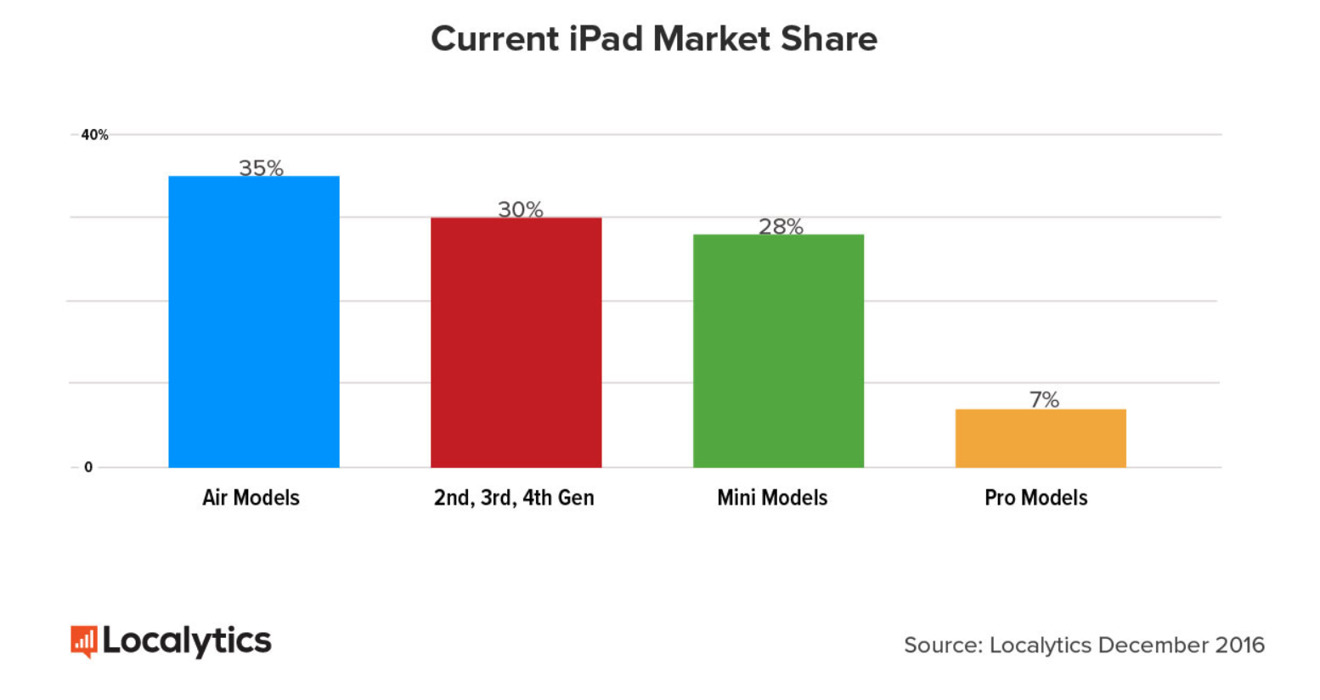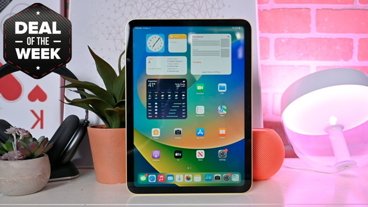While the rumored iPad Pro refresh has yet to happen, Tuesday's 9.7-inch form factor update serves as an affordable enticement to older iPad users from the iPad 2 to the iPad 4 to retire out-of-date equipment — and to do it now.
An oft-cited mantra of the tech press has been that the iPad 2 is the most populous model of iPad. While that has changed since 2015, the numbers still aren't all that far off from that moment in time.
As recently as December of 2016, a large amount of iPad users are still using pre-iPad Air hardware. According to analytical firm Localytics, users of the iPad 2, iPad 3, and iPad 4 are a whopping 30% of the installed base. The iPad mini sits at 28%, and the iPad Pro, including the 9.7-inch model sits at only 7%.
Personal reasons have probably kept most of the old gear alive. However, with the new iPad, there has never been a better time to upgrade.
Specs alone blow away older devices
When it's been a while since the last purchase in a family, the new gear tends to have better specifications on the surface — and the new iPad is no exception.
Those numbers don't always add up to real-world performance gains, but in this case, they do.
Performance
We've come a long way from the iPad 2. RAM has doubled, and processor clock speeds have as well. Plus, advancements in GPU technologies make newer devices that much faster.
We don't know about performance on the A9 processor in the new iPad yet. However, the iPhone SE with an A9 processor has a Geekbench rating of 4014. The iPad 4 has a benchmark of 1281, and the iPad 2 has a measly 570.
Security
The security reasons to buy the new iPad are clear — Apple's latest operating system is unavailable to the iPad 2 and iPad 3 owners, potentially leaving them open to some vulnerabilities discovered recently.
The iPad 4 is the oldest iPad that can run iOS 10. There are no guarantees that iOS 11 will maintain iPad 4 compatibility.
With more and more threats popping up, keeping users on an up-to-date platform who may not be interested in conventional computing countermeasures against threats has clear benefits. In all likelihood, the new 9.7-inch iPad will be able to get all the latest iOS updates for another five or six years.
Aging batteries
The last iPad 4 rolled off the production lines at some point in late 2013. That means that barring a battery replacement, we're looking at a three-year old battery.
Batteries rely on finite chemical processes. As a result, they have generally a three-year useful life on the average. While some will last longer, none of the surviving iPad 4 population should be anywhere near maximum capacity.
A new battery for an older iPad from a trustworthy vendor runs about 10% the cost of the new iPad, not even including the cost of labor or tools necessary to do it. Apple charges $100.
No reason to wait anymore
The only reason at this point to hang on to an older iPad is because you already own the older one. The next few years won't be kind to Apple's first four iPad models, with the original iPad basically put out to pasture with iOS 5 and of little use to anybody anymore.
Nobody's saying that you should toss your old iPad. Here at AppleInsider we'd be lying if we said that we didn't have an old iPad or two still kicking about performing some function or another — but none of them are connected to the internet, at all.
Security is paramount. The only way to guarantee that in internet travels is to be sure that you've got an up-to-date system — and Apple's new iPad is the same form factor as the original, and at its cheapest price point yet.
The iPad 2 and 3 just aren't safe anymore, and the iPad 4 isn't far behind.
 Mike Wuerthele
Mike Wuerthele









-m.jpg)






 Charles Martin
Charles Martin
 Christine McKee
Christine McKee
 Wesley Hilliard
Wesley Hilliard
 Malcolm Owen
Malcolm Owen
 Andrew Orr
Andrew Orr
 William Gallagher
William Gallagher
 Sponsored Content
Sponsored Content








64 Comments
If the iPad 2 still does everything someone wants then there's still no compelling reason to upgrade. There's no wow factor here. Nothing that makes someone say I gotta have this! Sure, maybe the price will lure some in, but as I've said before, I don't think price is an issue. If you release an iPad with features that make someone want to buy it, they'll buy it at yesterday's prices. I don't really see where at least on the consumer side where price has been an issue as of late. Even when the US was in a recession Apple had record sales.
Why'd they take away anti-reflective coating and the laminated display? My iPad 2 v2 still gets 10-11 hours battery life, i picked up the version with the shrunken die which at launch gave me around 15 hours battery life. The negatives now is that i can only have 1 tab open in safari now and it sometimes crashes if i load too much by continuously scrolling down. Netflix works fine still. I would of upgraded if they put 2GB of ram and made the minimum 64GB of space. Maybe the extra thickness in the new ipad is for more battery? hopefully tested. I'll wait another year till my ipad 2 dies.
While some users of iPad 2 are hanging on, it's the battery that will kick them off in the end. If you rely upon the device for casual consuming, then decent battery life is part of the package - and a 4-year-old machine is probably getting funky in that regard. These people are mainly using wifi-only models with the minimum 16GB of storage. That means that they can get a massive upgrade for only $329, a whole lot less than they paid for the original. Not bad, and clearly aimed at this crowd. This product really helps to distinguish the Pro line with a sharp delineation between consumption & productivity. I expect all the marketing around this new iPad to be about fun fun fun and content consumption, and the Pro marketing to be all about making stuff. Case closed (if I'm correct).